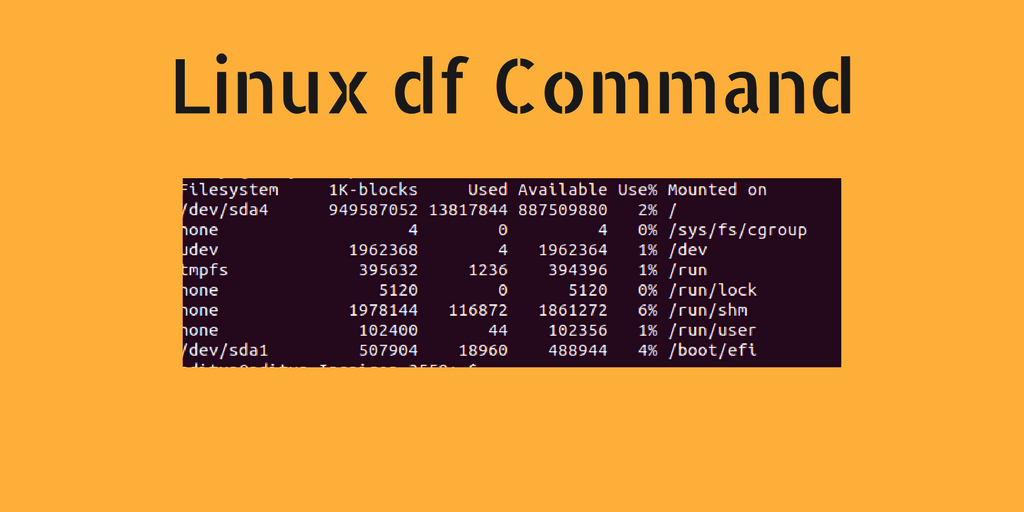Investigate Directories For Disk Usage
Sometimes it may be required to find out which directory consuming how much disk space especially when you are used df -h and realized your available disk space is low.
du:
du command summarizes disk usage of the set of FILEs, recursively for directories.
It’s often uses with -sh option:
-s, --summarize display only a total for each argument -h, --human-readable print sizes in human readable format (e.g., 1K 234M 2G)
For summarizing disk usages of the files in the current directory we use:
du -sh *
Example output:
572K Documents 208M Downloads 4,0K Music 724K Pictures 4,0K Public 4,0K Templates 4,0K Videos
We can also include hidden files with using:
du -sh .[!.]* *
Example output:
6,3M .atom 4,0K .bash_history 4,0K .bash_logout 8,0K .bashrc 350M .cache 195M .config 12K .dbus 4,0K .dmrc 44K .gconf 60K .gem 520K .gimp-2.8 28K .gnome 4,0K .ICEauthority 8,3M .local 8,0K .nano 404K .nv 36K .pki 4,0K .profile 8,0K .ssh 0 .sudo_as_admin_successful 4,0K .Xauthority 4,0K .xsession-errors 4,0K .xsession-errors.old 572K Documents 208M Downloads 4,0K Music 724K Pictures 4,0K Public 4,0K Templates 4,0K Videos
Thirdly, you can add total to the output by adding ,-c, option:
du -sch .[!.]* *
Result:
. . . 4,0K Templates 4,0K Videos 769M total
Most importantly using du command properly on the root directory is a life-saving action to find out what application/service or user is consuming your disk space wildly. For example, in case of a ridiculously low level of disk space availability for a web and mail server, the reason could be a spam attack to your mail service and you can diagnose it just by using du command.
Investigate root directory for disk usage:
sudo du -sch /.[!.]* /*
Example output:
16K /.VolumeIcon.icns 24K /.VolumeIcon.png 13M /bin 57M /boot 4,0K /cdrom 620K /dev 13M /etc 779M /home 0 /initrd.img 406M /lib 3,9M /lib32 4,0K /lib64 16K /lost+found 4,0K /media 4,0K /mnt 367M /opt du: cannot access '/proc/18221/task/18221/fd/4': No such file or directory du: cannot access '/proc/18221/task/18221/fdinfo/4': No such file or directory du: cannot access '/proc/18221/fd/4': No such file or directory du: cannot access '/proc/18221/fdinfo/4': No such file or directory 0 /proc 20K /root du: cannot access '/run/user/1000/gvfs': Permission denied 9,4M /run 13M /sbin 4,0K /srv 0 /sys 72K /tmp 3,5G /usr 639M /var 0 /vmlinuz 5,8G total
Lastly, the best method forms when you add a threshold size value for directories to ignore small ones. This command will only show folders with more than 1GB in size which located under root directory up to the farthermost branch of the whole directory tree in your file system:
sudo du --threshold=1G -ch /.[!.]* /*
Example output:
1,4G /usr/lib 1,8G /usr/share 3,5G /usr 5,8G total
Checking Disk Space
It’s quite common to want to check the status of the various partitions/drives on your server/computer to see how full they are. The following command is the one you’ll want to run:
df -h
This will produce output similar to the following:
[root@mail ~]# df -h Filesystem Size Used Avail Use% Mounted on /dev/mapper/VolGroup-lv_root 19G 1.6G 16G 9% / tmpfs 245M 0 245M 0% /dev/shm /dev/sda1 485M 47M 413M 11% /boot
In this basic example, we can see that the / partition only has 9% used.
For a more complex example that also covers using df to see various mountpoints, see below:
[root@mail ~]# df -h Filesystem Size Used Avail Use% Mounted on /dev/mapper/VG-root 1.9T 1.7T 89G 95% / /dev/mapper/VG-var 431G 145G 264G 36% /var devtmpfs 7.8G 204K 7.8G 1% /dev tmpfs 7.8G 4.0K 7.8G 1% /dev/shm /dev/md1 495M 126M 344M 27% /boot ku.example.com:9421 2.5T 487G 2.0T 20% /mnt/test tmpfs 500M 86M 415M 18% /var/ngx_pagespeed_cache
In this example, we have a / partition that’s 95% full along with an additional /var partition that’s only 36% full. It’s got an external network mount of 2T that’s mounted on /mnt/test and a ramdisk/tmpfs mount of 500M mounted on /var/ngx_pagespeed_cache.
